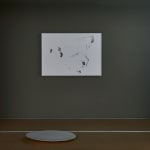Morita Shiryū (1912–1998)
Usobuku
Ink on paper, framed
1963
With a label signed by the artist
62 x 88 cm
63 x 90 cm (overall)
1963
With a label signed by the artist
62 x 88 cm
63 x 90 cm (overall)
Exhibitions
Sho: Modern Calligraphy by Shiryu Morita. New York: Mi Chou Gallery, 1963.Literature
Morita Shiryu Catalogue Raisonné: 1952–1998. Uji: Soryusha, 2019.
For Morita, 1963 was a significant year: It was around that time that he began to put much of his theories on modern Japanese calligraphy into practice. In the early 1950s, artists, scholars, and art critics from the Kansai area, including Morita himself, established interdisciplinary associations such as Genbi (abbr. for Gendai Bijutsu Kondankai, “Contemporary Art Discussion Group”) to exchange ideas on diverse manners of artistic expression. Over the course of extensive interdisciplinary discourse among the members of the groups, Morita crystalized his concepts on calligraphy. In “Is It Inappropriate to Translate ‘Sho’ as ‘Japanese Calligraphy?,” he argued that the essence of Japanese sho was far from merely expressing shape and line, or the beauty of the external. Each written character carries layers of meaning, cultivated by artists and practitioners as part of a long-standing tradition. This way, Morita emphasized the fundamental differences between seemingly calligraphic, abstract Western painting and Japanese sho.
At the very early stage of his career Morita might have already been aware of the imbalance in the art world where the West was perceived as the center of modernism and the rest of the world as peripheral. Considering this state of affairs, it is easier to comprehend Morita’s motivation for usobuku. Usobuku literally means “to roar.” The character is taken from the idiom ryu gin ko sho (dragon cries, tiger roars; note that the spelling usobuku changes to sho in a compound word), a metaphor of two fellows of the same kind acknowledge each other on an equal footing. By writing usobuku, Morita tried to address such existing power relationships of a dominant center and subordinated periphery, or, of influence and being influenced. Indeed, Morita was convinced that a unique culture and artistic tradition like the Japanese one should be recognized in its own right on the stage of world art, regardless of national and geographical differences.
Morita Shiryu (avant-garde calligrapher; 1912–1998)
Avant-garde calligrapher from Hyogo Prefecture. Like fellow artist Inoue Yuichi, Morita studied under the calligraphy master Ueda Sokyu. He co-founded the avant-garde group Bokujinkai together with Inoue and was the founder and editor of the journal Bokubi (Beauty of Ink), both of which revolutionized traditional Japanese calligraphy and spread knowledge of Japanese avant-garde calligraphy to an international audience. He was posthumously awarded the Medal of Honor with Dark Blue Ribbon.
At the very early stage of his career Morita might have already been aware of the imbalance in the art world where the West was perceived as the center of modernism and the rest of the world as peripheral. Considering this state of affairs, it is easier to comprehend Morita’s motivation for usobuku. Usobuku literally means “to roar.” The character is taken from the idiom ryu gin ko sho (dragon cries, tiger roars; note that the spelling usobuku changes to sho in a compound word), a metaphor of two fellows of the same kind acknowledge each other on an equal footing. By writing usobuku, Morita tried to address such existing power relationships of a dominant center and subordinated periphery, or, of influence and being influenced. Indeed, Morita was convinced that a unique culture and artistic tradition like the Japanese one should be recognized in its own right on the stage of world art, regardless of national and geographical differences.
Morita Shiryu (avant-garde calligrapher; 1912–1998)
Avant-garde calligrapher from Hyogo Prefecture. Like fellow artist Inoue Yuichi, Morita studied under the calligraphy master Ueda Sokyu. He co-founded the avant-garde group Bokujinkai together with Inoue and was the founder and editor of the journal Bokubi (Beauty of Ink), both of which revolutionized traditional Japanese calligraphy and spread knowledge of Japanese avant-garde calligraphy to an international audience. He was posthumously awarded the Medal of Honor with Dark Blue Ribbon.



